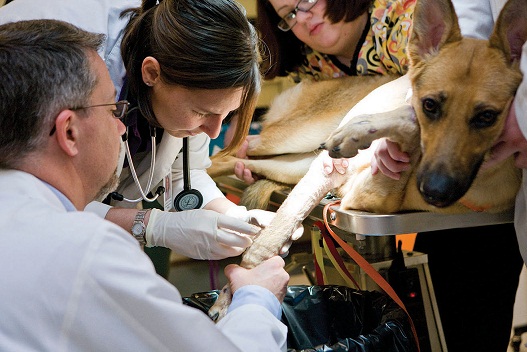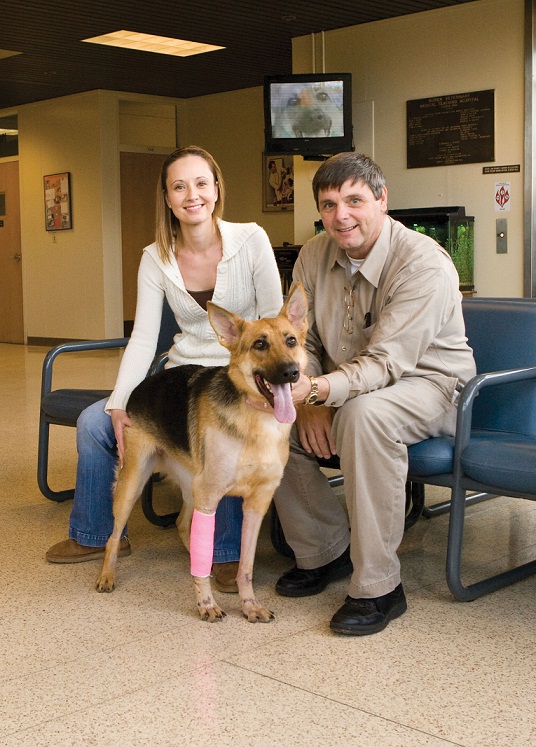A Chance for Bella
Tuesday, March 1, 2011

“It was December 23,” recalls Henderson. “As we were crossing an overpass, we were sideswiped by a tractor trailer. We spun around and the Jeep Liberty flipped over. I’m not sure when it happened, but the dogs, who were in the closed cargo area in the back of the Jeep were ejected from the vehicle.”
Sadly, their black Labrador retriever died in the accident. Henderson and Foster had bumps and bruises but nothing serious. However, Bella, their 1-year 8-month-old female German Shepherd, wasn’t as lucky as her owners.
“We found Bella standing in the middle of the road on three legs holding her broken leg up. It just hung there with multiple fractures,” says Henderson. “We put a tourniquet around her leg to stop the bleeding. It was so cold I just held her by the side of the road trying to get her warm.”
They took Bella to a veterinarian in Amarillo, Texas, who stabilized Bella’s leg and kept her overnight.
“The next day was Christmas Eve, and the veterinarian was closing for the holiday. We had to pick her up. By then Scott’s dad, Toby Foster, had borrowed an Expedition to come get us,” Henderson says. “We picked up Bella and headed to Stillwater in a snowstorm to bring Bella to OSU.”
Bella arrived in the emergency room at OSU’s Boren Veterinary Medical Teaching Hospital on Christmas morning. Dr. Todd Yeagley, rotating small animal medicine and surgery intern, was waiting at the hospital for triage upon Bella’s arrival. Assigned to her case were Dr. Danielle Pawloski, second-year resident in small animal surgery, Melissa Kehl, fourth-year veterinary student, and Dr. Mark Rochat, Diplomate of the American College of Veterinary Surgeons and chief of small animal surgery.
“Bella had road rash on her chin with a laceration and road rash on all of her knuckles on her left front leg,” Pawloski explains. “Both the radius and ulna were fractured on her right front leg, and the facture was exposing the bones and muscle and tendons surrounding the bone to the environment.”
According to Pawloski, this type of injury to a fractured leg is a degloving injury.
“Basically the skin gets removed off of the underlying tissue, leaving no skin to cover the large open fracture. The veterinarian in Amarillo bandaged the fracture to protect it from the environment,” she says, “but because they were delayed by closed roads related to bad weather, Bella’s fracture was two days old when she arrived and still contained a large amount of gravel and debris from the accident.”
Pawloski informed the owners that repairing the fracture, cleaning the soft issues, flushing out dead tissue and debris, and closing or grafting the skin would require multiple trips to the operating room. Henderson and Foster agreed to give Bella a chance.
“Christmas morning we placed a bone plate and screws on the radius and an intramedullary pin inside the ulna to repair Bella’s fractures. After we cleaned the soft tissues and removed dead issue, we bandaged the wounds to provide a barrier for the fractured bone and new plate,” Pawloski says.
“Keeping the plate protected from the environment is extremely important to prevent any infection from developing due to exposure.”
They monitored Bella for pain in the hospital’s newly renovated Kirkpatrick Foundation Small Animal Critical Care Unit. Due to the holiday schedule, the team transferred Bella’s care to Dr. Brent Newcomb, third-year resident in small animal surgery. Under his care, Bella made six more trips to surgery to have the skin treated and finally closed.
“We were able to close the skin without having to do any skin grafts,” Pawloski says. “We are thankful that we had the opportunity to perform such extensive surgical procedures to make Bella feel better.”
This is the first time Henderson used the veterinary services available at OSU, and she couldn’t be more pleased. “The level of expertise and customer service has been amazing and has far exceeded our expectations,” she says. “Bella is expected to make a full recovery.”
An energetic Bella returned to OSU with Henderson to have her staples removed and a check up.
“Bella has been crated most of the time to keep her from putting too much pressure on her broken leg,” Henderson says. “She is definitely excited to be out. She is so much better, and I am so happy. I was really worried about her for awhile. Thank goodness we were able to get her to OSU!”

